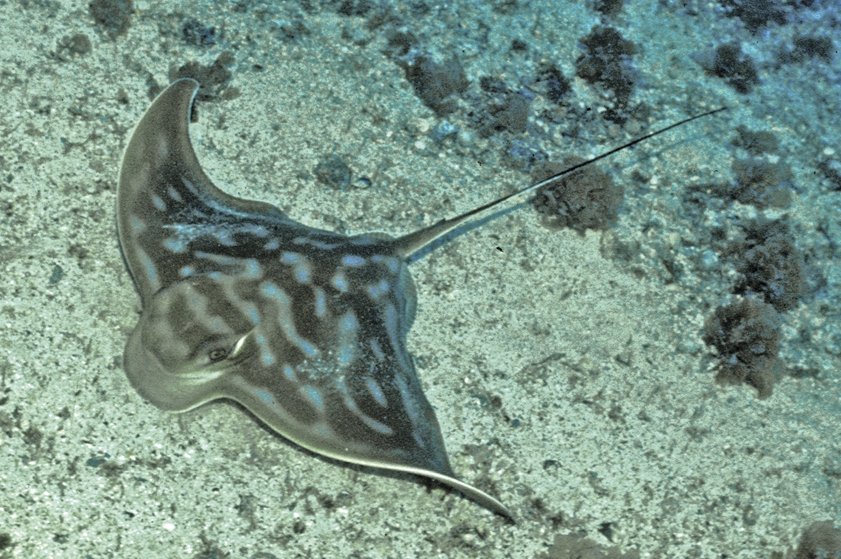- Classification
- CHONDRICHTHYES
- MYLIOBATIFORMES
- MYLIOBATIDAE
- Myliobatis
- tenuicaudatus
Southern Eagle Ray, Myliobatis tenuicaudatus Hector 1877
Other Names: Eagle Ray, New Zealand Eagle Ray

Southern Eagle Ray, Myliobatis tenuicaudatus. Source: Rudie H. Kuiter / Aquatic Photographics. License: All rights reserved
Summary:
A large brownish, greyish, greenish or yellowish eagle ray with a variable pattern of greyish-blue spots and bars, and a venomous spine on the whip-like tail.
Until recently, the Southern Eagle Ray, was called Myliobatis australis in Australia (a junior synonym of M. tenuicaudatus).
A Southern Eagle Ray at Shelly Beach, Manly, New South Wales.
A Southern Eagle Rays feeding in the shallows in southwestern Australia.
Until recently, the Southern Eagle Ray, was called Myliobatis australis in Australia (a junior synonym of M. tenuicaudatus).
A Southern Eagle Ray at Shelly Beach, Manly, New South Wales.
A Southern Eagle Rays feeding in the shallows in southwestern Australia.
Cite this page as:
Bray, D.J. 2023, Myliobatis tenuicaudatus in Fishes of Australia, accessed 27 Jun 2025, https://fishesofaustralia.net.au/home/species/3545
Southern Eagle Ray, Myliobatis tenuicaudatus Hector 1877
More Info
|
Distribution |
Widespread in southern Australia, from Moreton Bay, Queensland (and possibly further north), to Shark Bay, Western Australia; also Norfolk Island in the Tasman Sea. Elsewhere, the species occurs in New Zealand. Inhabits rocky reefs, sandflats, shallow seagrass embayments, and tidal flats in estuaries and harbours, mostly at depths above 50 m. |
|
Features |
Disc wider than long, with angular tips; snout blunt, eyes on sides of head, spiracles conspicuous; leading edges of pectoral fins originating below eyes. Dorsal fin small, originating just behind trailing margin of pelvic fin; tail long, whip-like with a venomous spine. |
|
Size |
Brownish, grey, olive-green or yellowish above, paler below; upper surface with a variable pattern of grey-blue spots and bars. |
|
Feeding |
Feeds on bivalve molluscs, polycheate worms and crustaceans. |
|
Biology |
Viviparous (matrotrophic) species with litters of 2-20 (average 6) young per breeding cycle with birth occurring in summer months. Size at birth 20-30 cm DW. |
|
Fisheries |
Taken as bycatch in demersal gillnet, setline, longline, beach and Danish seine fisheries, and by demersal prawn and scallop trawlers. Although not directly targeted, Southern Eagle Rays are increasingly being retained and sold for consumption. |
|
Etymology |
The specific name tenuicaudatus is from the Latin tenuis (= thin, slender) and caudatus (= tailed), in reference to the very slender tail of this species. |
|
Species Citation |
Myliobatis tenuicaudatus Hector, 1877, Trans. N. Z. Inst. 9(62): 468, Pl. 10. Type locality: Wellington Harbour, New Zealand. |
|
Author |
Bray, D.J. 2023 |
|
Resources |
Southern Eagle Ray, Myliobatis tenuicaudatus Hector 1877
References
Compagno, L.J.V. & Last, P.R. 1999. Families Gymnuridae, Myliobatidae, Rhinopteridae, Mobulidae. pp. 1505-1529 in Carpenter, K.E. & Niem, V.H. (eds). The Living Marine Resources of the Western Central Pacific. FAO Species Identification Guide for Fisheries Purposes. Rome : FAO Vol. 3 pp. 1397-2068. (as Myliobatis australis and M. tenuicaudatus)
Daley, R.K., Stevens, J.D., Last, P.R. & Yearsley, G.K. 2002. Field Guide to Australian Sharks & Rays. Hobart : CSIRO Marine Research 84 pp. (as Myliobatis australis)
Grant, E.M. 1975. Guide to Fishes. Brisbane : Queensland Government, Co-ordinator General’s Department 640 pp. (as Myliobatis australis)
Hector, J. 1877. Notes on New Zealand ichthyology. Transactions New Zealand Institute 9(62): 465-469, Pls. 8-9. See ref at BHL
Hines, A.H., Whitlatch, R.B., Thrush, S.F., Hewitt, J.E., Cummings, V.J., Dayton, P.K. & Legendre, P. 1997. Nonlinear foraging response of a large marine predator to benthic prey: eagle ray pits and bivalves in a New Zealand sandflat. Journal of Experimental Marine Biology and Ecology 216: 191–210.
Kuiter, R.H. 1993. Coastal Fishes of South-eastern Australia. Bathurst : Crawford House Press 437 pp. (as Myliobatis australis)
Kuiter, R.H. 1996. Guide to Sea Fishes of Australia. A comprehensive reference for divers and fishermen. Sydney, NSW, Australia : New Holland Publishers xvii, 434 pp. (as Myliobatis australis)
Kyne, P.M. 2016. Myliobatis tenuicaudatus. The IUCN Red List of Threatened Species 2016: e.T70686656A70687032. https://dx.doi.org/10.2305/IUCN.UK.2016-1.RLTS.T70686656A70687032.en. Accessed on 08 March 2022.
Last, P.R., Scott, E.O.G. & Talbot, F.H. 1983. Fishes of Tasmania. Hobart : Tasmanian Fisheries Development Authority 563 pp. figs. (as Myliobatis australis)
Last, P.R. & Stevens, J.D. 1994. Sharks and Rays of Australia. Canberra : CSIRO Australia 513 pp. 84 pls. (as Myliobatis australis)
Last, P.R. & Stevens, J.D. 2009. Sharks and Rays of Australia. Collingwood : CSIRO Publishing Australia 2, 550 pp.
Macleay, W.J. 1881. Descriptive catalogue of the fishes of Australia. Part 4. Proceedings of the Linnean Society of New South Wales 1 6(2): 202-387. (described as Myliobatis australis, type locality - Port Jackson) See ref at BHL
McCulloch, A.R. 1911. Report on the fishes obtained by the F.I.S. Endeavour on the coasts of New South Wales, Victoria, South Australia and Tasmania. Part 1. Zoological (Biological) Results. Endeavour 1(1): 1-87 figs 1-20 pls 1-16 (as Aetobatus australis)
Whitley, G.P. 1940. The Fishes of Australia. Part 1. The sharks, rays, devil-fish, and other primitive fishes of Australia and New Zealand. Sydney : Roy. Zool. Soc. N.S.W. 280 pp. 303 figs. (as Myliobatis australis)
White, W.T. 2014. A revised generic arrangement for the eagle ray family Myliobatidae, with definitions for the valid genera. Zootaxa 3860(2): 149–166.














